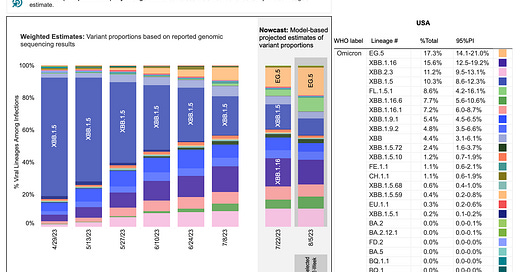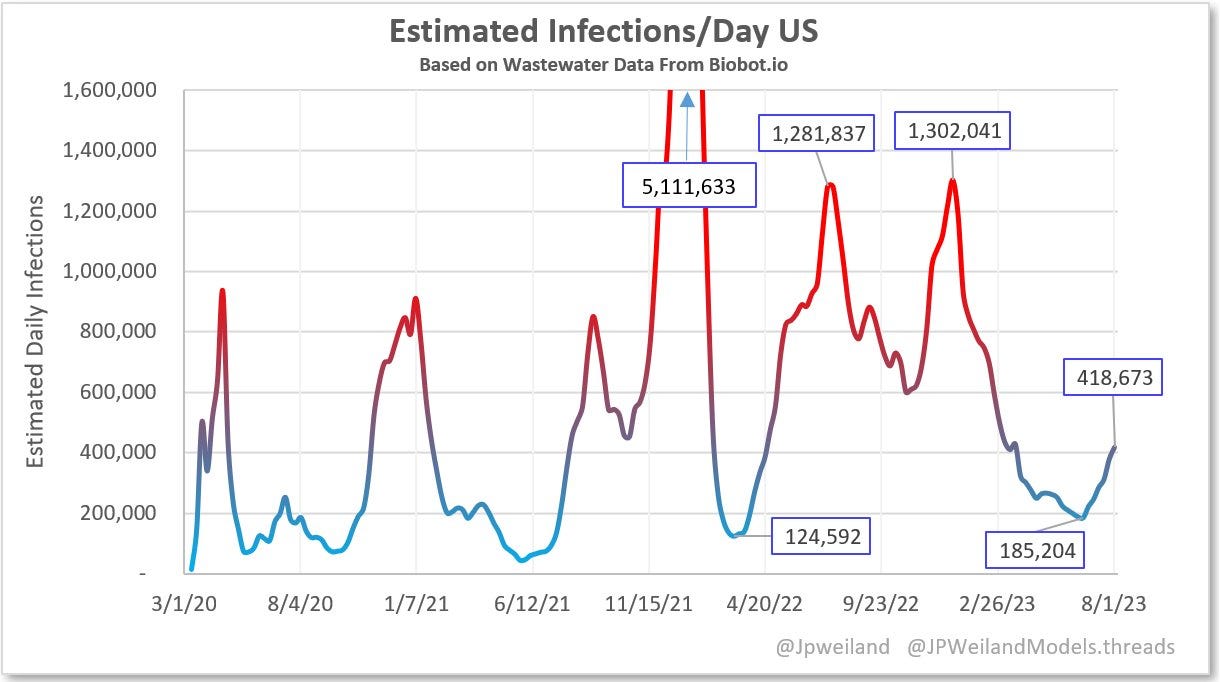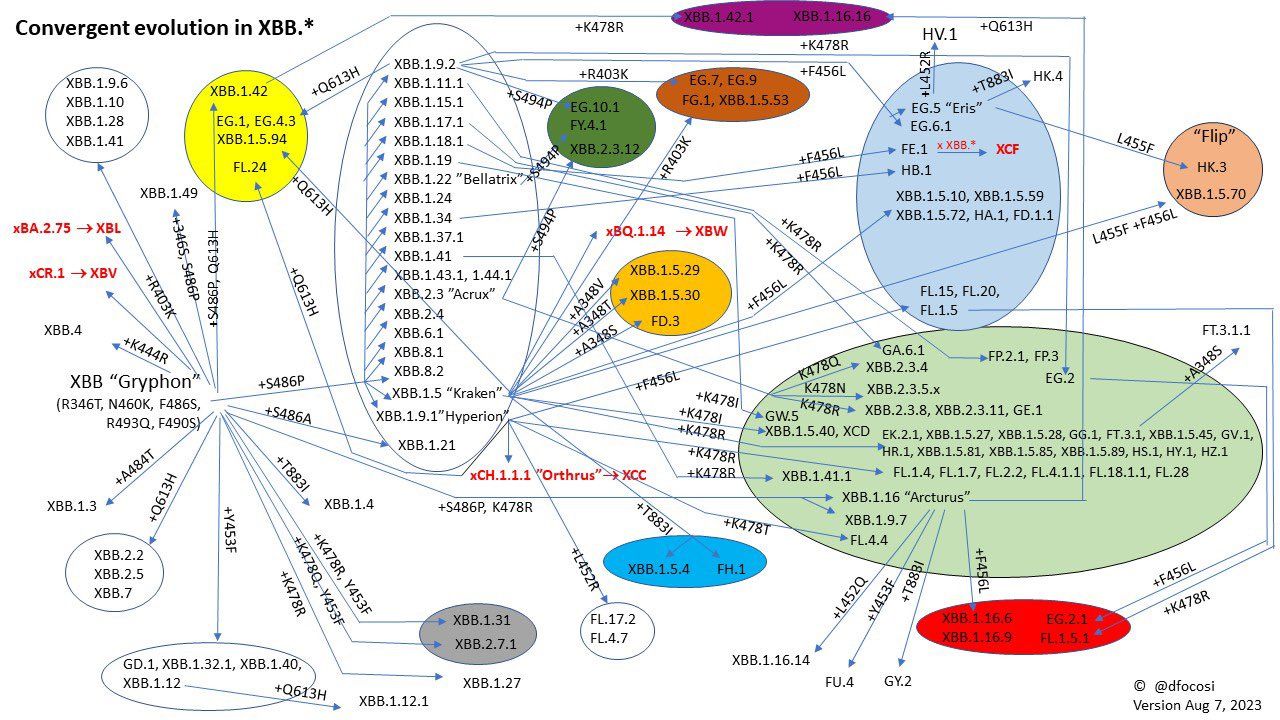The Virus is Learning New Tricks and We Humans Keep Falling Behind
The new SARS-CoV-2 variant (EG.5.1), how we are about to FLip, and where are the new Covid boosters?
This week the CDC genomic surveillance showed continued rise of the EG.5.1 variant with near doubling over the past couple of weeks, showing significant growth advantage compared to its prevailing XBB variant precursors (such as XBB.1.5, XBB.1.16, XBB.1.9)
The rise of EG.5.1 is not at all confined to the United States. It’s notable throughout the UK, Europe, and Asia. The graphs below, posted by Mike Honey , show its takeoff well.
In fact, the proportion of new sequences with the key spike mutation seen in EG.5 (and FL.5.1)—F456L—is over 35% worldwide.
Is it Clinically Meaningful?
Wastewater surveillance (biobot.io) shows a new wave in the United States and this graph by JP Weiland estimates the number of cases that translates to, and to date this has been accompanied by a >10% rise in Covid hospitalizations, and no rise (yet) in deaths. It should be noted that the tracking of hospitalizations and deaths is far from optimal, forcing us to rely chiefly on wastewater levels to get a handle on what is going on.
There’s nothing to connect the dots between EG.5.1 and this wave, which, while noteworthy and concerning, is not anything like Omicron-it’s <10%. We don’t know when this wave will peak, and whether the rise of EG.5.1 is contributing. It certainly does not look benign. Don’t ever forget the toll of Long Covid that results from such waves.
EG.5.1 was just profiled in the lab by Yunlong Cao’s lab, the group that has been out in front throughout the pandemic for accurately and rapidly assessing new variants and their functional significance. This variant with F456L, and another we’ll be discussing shortly (L455F), are very likely an outgrowth of escape mutations from wide use of monoclonal antibodies and were predicted to occur many months ago.
The impact of EG.5.1 for neutralizing antibodies is seen below for individuals with both BA.5 and an XBB (1.5 or 1.16) infections. You can see the drop of neutralizing antibody levels (Plasma NT50) when the F456L mutation is added to XBB.1.5 and for EG.5.1 which carries this mutation. So the EG.5.1 variant poses a challenge to our humoral (antibody) immune response.
The Upcoming FLip Combo Mutation
There are 2 adjacent mutations in the spike 455 and 456 positions that are showing the virus has learned a new trick. It’s being called a FLip because both mutations are between F and L: one L to F, the other F to L, such that it really is deserving of the name!, thanks to Raj Rajnarayanan for coming up with it). Together, but not alone, the spike binds more avidly to ACE2, the cell receptor for the virus (the lower the Y-axis, -logKd the tighter the binding).
And, as seen above in the neutralizing antibody graph, this FLip combo mutation also leads to further reduction of neutralizing antibodies. This certainly suggests this evolution of the virus will be more troubling than EG.5.1 and we can expect it to show further growth advantage in the weeks ahead.
At present, it is at low levels globally (~2%), but there are places where the FLip is taking off, such as Brazil and Spain, as shown below from Mike Honey’s graph.
Here is Daniele Focosi’s newly updated XBB Convergence map to show the evolution of the FLip combo mutation at the far right, top, with EG.5.1 adding the L455F mutation.
We’re Not Ready
We’re not ready for EG.5.1, no less FLip. We were supposed to have new Covid booster vaccines available in August directed against XBB.1.5, the prevailing and dominant variant when the decision was made to make it the target back in May/June. Below is the spike protein mutation map for BA.5 (to which the bivalent booster shot was directed), XBB.1.5 (the target of the new booster), and EG.5.1.
As you can see, there is very close alignment between XBB.1.5 and EG.5.1 except for 2 new mutations in the latter: F456L and Q52H. Accordingly, the new Covid booster should be very effective vs severe Covid. On the other hand, the BA.5 spike has more than 15 different mutations than either of the newer variants, which not only reflect further evolution of the virus, but also how poorly aligned that bivalent BA.5 booster is with the virus circulating now. Even with FLip gaining traction, we’d be far better off with the new XBB.1.5 monovalent booster than what we have now.
The new Covid booster was expected in late August or early September, but recently the new CDC director, Mandy Cohen said on NPR it may not be available until October. That’s an unacceptably long delay from the initial projection and expectations, especially with what has been happening with the virus’s evolution. No less the timing that schools are starting soon. Too many high-risk people, because of being immunocompromised or of advanced age, will unnecessarily be vulnerable to hospitalizations or deaths.
To be clear, we are not looking at an “Omicron event” now, whereby there will be a dramatic increase in transmission and adverse outcomes due to a boatload of new mutations. But these changes in the spike of the virus (and other components not reviewed here, such as in the ORF1a, ORF1b, the nucleocapsid, etc) are a signal that there’s more to come with SARS-CoV-2 and we have a bad track record of always lagging behind. And as I previously reviewed, we have an estimated 20% chance of having another Omicron event in the next couple of years—one that would certainly challenge prior immunity, be it by vaccinations, infections, or their combination.
The $5 billion Project NextGen is supposed to be accelerating nasal vaccines, better variant-proof universal vaccines, and monoclonal antibodies that work, but there’s no sign of life yet for this initiative.
Bottom Line
With all the complacency about Covid, it’s no wonder we keep trailing its progression. We need to get serious about getting the new XBB.1.5 boosters out ASAP, and getting Project NextGen in high gear. The “pandemic is over” culture is the last thing we need to confront the pressure we’ve put on the virus to find new ways to get us—to find repeat and new hosts—and evade our prior immunity. The FLip double whammy exploits 2 ways at once with tighter binding to the receptor and incremental immune evasion. Whatever tricks beyond FLip the virus will find are not known, but what is incontrovertible is that SARS-CoV-2 will unfortunately be with us for many, many years to come. Yet we’re not using our big advantage—human intelligence—to get ahead of it. Even just getting an updated, monovalent, well aligned (XBB.1.5) booster out there in a timely manner, which is not a monumental achievement, by any means. We can and must do better than this…..
Thanks for reading Ground Truths! Please share it you found it useful.
Special thanks to Yunlong Cao, Ryan Hisner, Mike Honey, JP Weiland, T. Ryan Gregory, Daniele Focosi, Raj Rajnarayanan, and Federico Gueli for posts and insights that helped me write this edition of Ground Truths.










